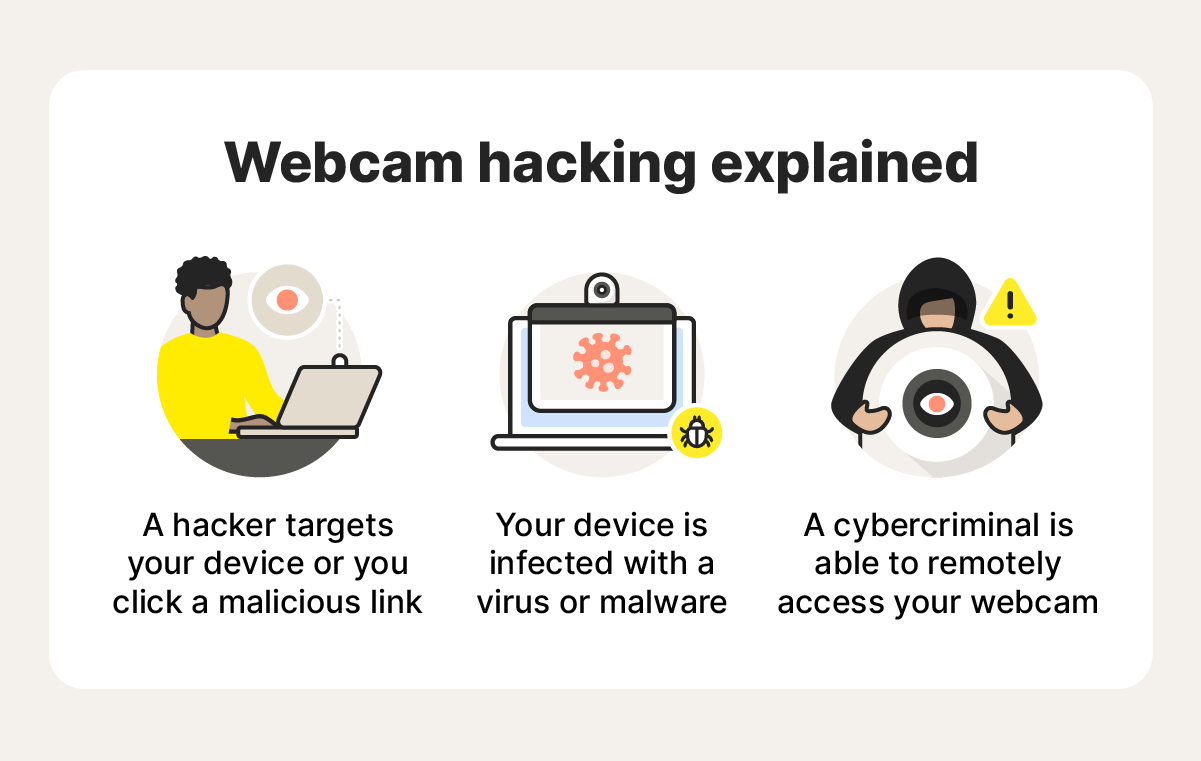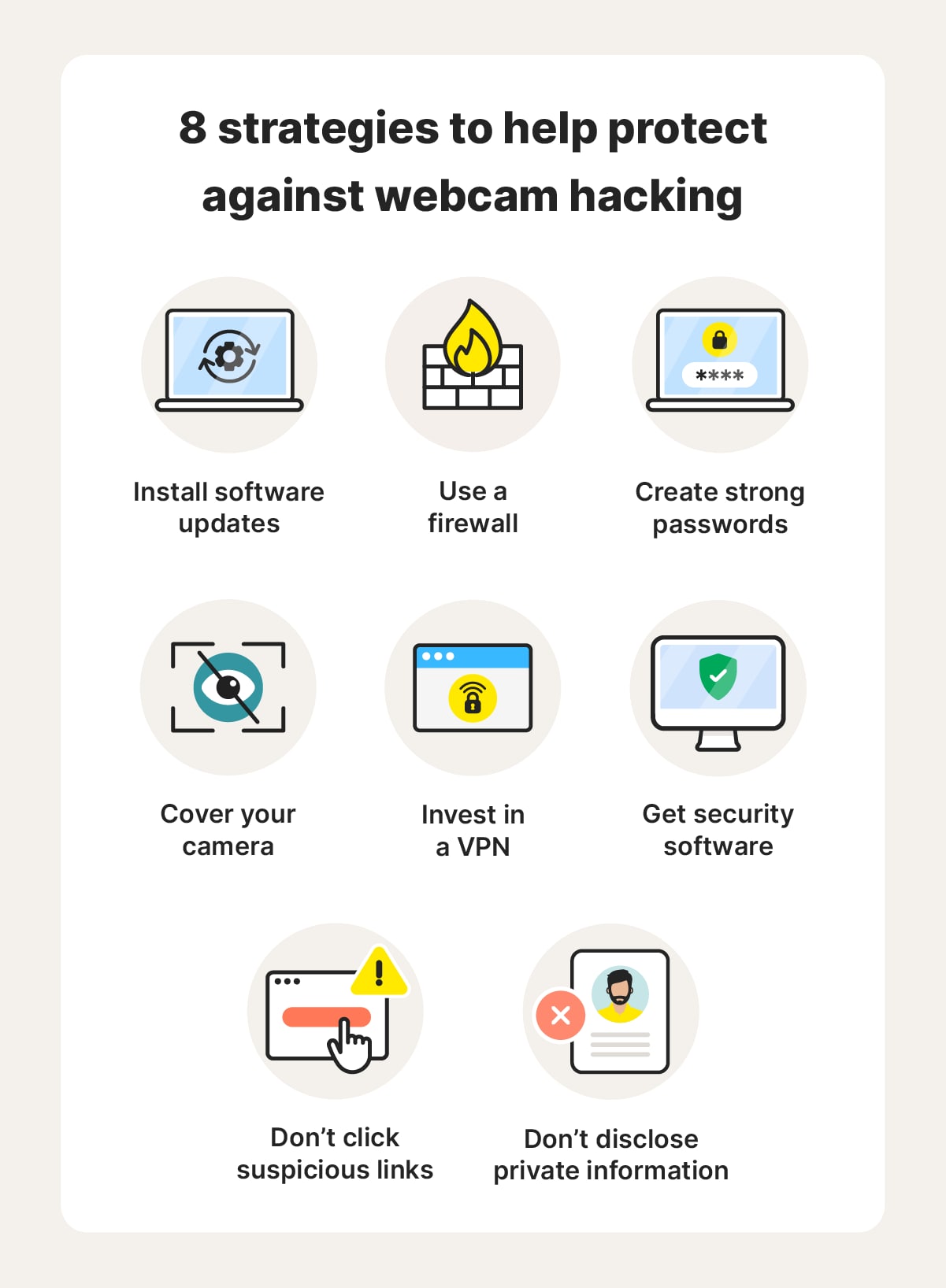Hacked webcam? How to spot and prevent webcam spies
A hacked webcam is a major privacy violation that could leave you vulnerable to blackmail or identity theft. Learn how it works, what the warning signs of webcam spying are, and how to help prevent webcam hacking. Then, get Norton 360 Deluxe for comprehensive device, network, and webcam security.

What is webcam hacking?
Webcam hacking, or camfecting, occurs when cybercriminals access a device’s camera without the user’s knowledge or consent. Webcam hackers remotely activate the camera, often through code contained in a malicious computer virus, to illegally view and record footage.
While camfecting is typically associated with PCs, it’s a threat on any digital device equipped with a camera, meaning that even your phone camera can be hacked. But it also includes Macs, phones, tablets, and even certain smart TVs. Hackers may have diverse motives to access webcams, from predatory snooping to recording compromising footage and blackmailing the victim.


Now you know how a webcam can be hacked, how common is webcam hacking? Well, webcam hacking poses a risk to anyone with a camera-equipped digital device. And there have been many high-profile examples, including a 2013 incident involving a blackmail attack on a Miss Teen USA. Fortunately, understanding how webcam hacking works and adhering to good cyber hygiene and webcam safety practices can mitigate your chances of falling victim.
How do webcams get hacked?
Cybercriminals primarily use malware, particularly Remote Access Trojans (RAT), to hack webcams. These Trojans hide within seemingly harmless files or programs, tricking victims into installation through download links on social media, messaging apps, or malicious websites. Once installed, webcam hackers can remotely access the webcam without the user’s knowledge, and view or record footage.
How to know if your webcam is hacked
Several signs can indicate your webcam has been hacked, including suspicious new applications appearing on your device and your camera light staying on even when you’re not using the webcam.
These are some of the top warning signs to look out for:
- The camera indicator light is on: Most webcams have a light that indicates if the camera is activated. It should only ever be lit when you’re actively using your webcam, so be wary if it stays on when your camera is supposed to be turned off.
- Your internet usage is unusually high: If a hacker is watching you through your webcam, your internet data usage will likely increase because of the footage being transmitted over your connection. Look out for suspicious upticks.
- Your battery is draining quickly: Webcams use power, just like any other device component. Your device’s battery draining more quickly than usual could be a sign that your webcam has been hacked and the footage is being transmitted elsewhere.
- New files or applications appear on your device: Files, third-party applications, or browser extensions can contain spyware that gives hackers access to your camera. If you notice suspicious apps or programs you didn’t download, uninstall them.
- Your webcam settings have changed: Hackers may need to change your webcam or device security settings to be able to access and record your camera without consent. Check your settings regularly to make sure they’re not changing ‘automatically’.
- Your webcam is glitching while you use it: Webcam glitches like screen tearing or video lag are typically a harmless result of slow internet speeds. However, they can also signal that your webcam has been compromised.
- You receive extortion messages: A coercive email or text message claiming someone has recorded footage of you through your webcam is highly likely to be a ruse. However, if it’s paired with other warning signs, take action to protect yourself and contact law enforcement.
- A scan detects malware or a virus on your device: Since webcam hacking is often the result of malware or a virus, you can run a malware scan to check if your device is compromised. Remove any malware the scan finds to re-secure your device.
How to help prevent webcam hacking
If you’re wondering how to help prevent webcam hacking, take cybersecurity best practices seriously. Keeping your device up to date, being cautious online, and using dedicated security software goes a long way to keeping you safer from webcam hackers.
Here’s how to make sure you aren’t an easy webcam hacking target:
- Update your operating system: Whether you use Windows, Apple, Android, iOS, or another operating system like Linux, keeping it up to date ensures that you have the latest security patches and features, which can help protect your device from new malware.
- Use a firewall: A firewall is a network security system that monitors network traffic and attempts to prevent unauthorised network access. Installing a firewall can help prevent hackers from accessing your device and by extension your webcam.
- Create strong passwords: Creating secure passwords for all of your user accounts, including your email and social media accounts, can help keep them safe from brute-force attacks and unauthorised access that could lead to your webcam being hacked.
- Cover your camera: The simple step of using a webcam cover (or even a sticker or piece of tape) to manually obstruct your webcam’s view when you’re not using it means that even if a hacker does get access, they won’t be able to see you.
- Avoid clicking suspicious links: Viruses and malware are often transmitted through links that prompt malicious downloads. Exercise caution when you’re browsing the internet and beware of potential phishing links in messages or emails.
- Protect your personal information: Sharing personal information with bad actors can leave you vulnerable to hacking, which can put your webcam’s security at risk. Protect your personal information by only sharing it with trusted people.
- Use a virtual private network: Using a VPN encrypts your network connection to help secure your online communications, conceal your IP address, and protect your device on public Wi-Fi networks. This helps protect webcam streaming and other internet traffic from hackers.
- Install security software: Norton 360 Deluxe can help you safeguard up to threefive devices against diverse webcam hacking threats, including viruses, spyware, and malware. It also features a built-in webcam protection tool, SafeCam for PCs, which works to notify you when cybercriminals or applications try to access your camera without your permission and helps you block their attempts.


Help boost your webcam security with Norton 360 Deluxe
Understanding how hackers might target you and what you can do to avoid them is a great first step in protecting yourself against webcam hacking. However, Norton 360 Deluxe provides a valuable additional safeguard against threats.
With powerful antivirus and malware protection features, a built-in VPN, and dark web monitoring, you benefit from an array of tools to help you stay safer online — including a SafeCam feature for PCs that specifically protects against webcam hacking. Get Norton 360 Deluxe today to help keep your private life truly private.
FAQs about webcam hacking
Can webcams still be hacked?
Yes, webcams can still be hacked. In fact, the threat of camfecting is arguably more relevant now than ever, as more and more devices like phones, tablets, and smart TVs come equipped with cameras.
Why is my camera light on when I’m not using it?
The most likely reason for your webcam or phone camera light being on when you’re not using it is that you’ve forgotten to close an app or program capturing video, such as FaceTime or Zoom. Try closing all apps and restarting your device. If the light stays on, it could indicate that your camera is being accessed remotely. In that case, cover the camera and run a malware scan.
Can your webcam be on if the light isn’t?
If your computer or phone’s camera light is controlled by software, as opposed to being wired to the camera hardware, it’s possible for hackers to manually disable it even when they’re accessing your camera. That means the camera indicator light isn’t always a reliable indicator of webcam hacking.
How do I know if my webcam is on?
Under normal circumstances, you can tell if your webcam is turned on by checking for the indicator light. There’s no easy way to check if your webcam is on when the light is off, but you can run a malware scan and use software features like SafeCam in the Norton 360 Deluxe suite to help reassure and protect yourself.
What are the two dots next to my laptop camera?
Not all laptops have two dots next to the webcam. However, if yours does, one is likely an LED that notifies you when the camera is turned on and the other might be a microphone. In some cases, dots next to your webcam can be a ‘sensor array’ responsible for automatic brightness adjustments.
Editorial note: Our articles provide educational information for you. Our offerings may not cover or protect against every type of crime, fraud, or threat we write about. Our goal is to increase awareness about Cyber Safety. Please review complete Terms during enrollment or setup. Remember that no one can prevent all identity theft or cybercrime, and that LifeLock does not monitor all transactions at all businesses. The Norton and LifeLock brands are part of Gen Digital Inc.









Want more?
Follow us for all the latest news, tips, and updates.